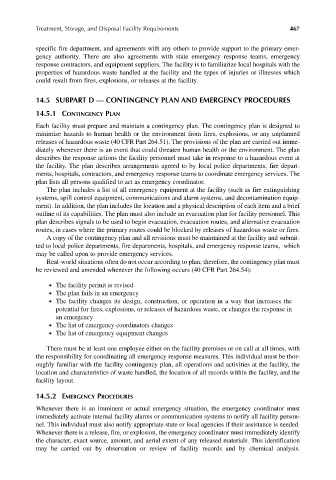Page 496 - Materials Chemistry, Second Edition
P. 496
CAT3525_C14.qxd 1/27/2005 12:37 PM Page 467
Treatment, Storage, and Disposal Facility Requirements 467
specific fire department, and agreements with any others to provide support to the primary emer-
gency authority. There are also agreements with state emergency response teams, emergency
response contractors, and equipment suppliers. The facility is to familiarize local hospitals with the
properties of hazardous waste handled at the facility and the types of injuries or illnesses which
could result from fires, explosions, or releases at the facility.
14.5 SUBPART D — CONTINGENCY PLAN AND EMERGENCY PROCEDURES
14.5.1 CONTINGENCY PLAN
Each facility must prepare and maintain a contingency plan. The contingency plan is designed to
minimize hazards to human health or the environment from fires, explosions, or any unplanned
releases of hazardous waste (40 CFR Part 264.51). The provisions of the plan are carried out imme-
diately whenever there is an event that could threaten human health or the environment. The plan
describes the response actions the facility personnel must take in response to a hazardous event at
the facility. The plan describes arrangements agreed to by local police departments, fire depart-
ments, hospitals, contractors, and emergency response teams to coordinate emergency services. The
plan lists all persons qualified to act as emergency coordinator.
The plan includes a list of all emergency equipment at the facility (such as fire extinguishing
systems, spill control equipment, communications and alarm systems, and decontamination equip-
ment). In addition, the plan includes the location and a physical description of each item and a brief
outline of its capabilities. The plan must also include an evacuation plan for facility personnel. This
plan describes signals to be used to begin evacuation, evacuation routes, and alternative evacuation
routes, in cases where the primary routes could be blocked by releases of hazardous waste or fires.
A copy of the contingency plan and all revisions must be maintained at the facility and submit-
ted to local police departments, fire departments, hospitals, and emergency response teams, which
may be called upon to provide emergency services.
Real-world situations often do not occur according to plan; therefore, the contingency plan must
be reviewed and amended whenever the following occurs (40 CFR Part 264.54):
● The facility permit is revised
● The plan fails in an emergency
● The facility changes its design, construction, or operation in a way that increases the
potential for fires, explosions, or releases of hazardous waste, or changes the response in
an emergency
● The list of emergency coordinators changes
● The list of emergency equipment changes
There must be at least one employee either on the facility premises or on call at all times, with
the responsibility for coordinating all emergency response measures. This individual must be thor-
oughly familiar with the facility contingency plan, all operations and activities at the facility, the
location and characteristics of waste handled, the location of all records within the facility, and the
facility layout.
14.5.2 EMERGENCY PROCEDURES
Whenever there is an imminent or actual emergency situation, the emergency coordinator must
immediately activate internal facility alarms or communication systems to notify all facility person-
nel. This individual must also notify appropriate state or local agencies if their assistance is needed.
Whenever there is a release, fire, or explosion, the emergency coordinator must immediately identify
the character, exact source, amount, and aerial extent of any released materials. This identification
may be carried out by observation or review of facility records and by chemical analysis.

